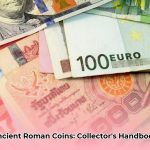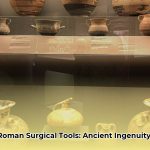Ever held a piece of tangible history? Roman currency offers precisely that: a direct connection to a civilization that shaped the Western world. Far more than mere transactional objects, these coins mirrored the empire’s triumphs, propagated its ideologies, and ultimately, bore witness to its economic struggles. This comprehensive guide delves into the fascinating evolution of Rome’s monetary system, its strategic use as an imperial tool, the challenges of debasement, its lasting global legacy, and practical insights for modern collectors.
The Genesis and Evolution of Rome’s Monetary System
Before the striking of metal discs, Roman wealth was intrinsically linked to livestock, a legacy preserved in the Latin word for money, “pecunia,” derived from “pecus” meaning cattle. This agrarian exchange gradually transitioned to more tangible forms of wealth, initially rough chunks of cast bronze known as “Aes Rude.” These rudimentary units, weighing around 320 grams, facilitated early trade across the Italian peninsula, serving as a prototype for more sophisticated coinage.
The progression continued with “Aes Signatum,” large bronze ingots weighing approximately 1.5 kilograms, often marked with distinctive symbols. Simultaneously, “Aes Grave,” heavy cast bronze disks, emerged as the basic monetary unit, with the As (Roman pound or libra, about 324 grams) divided into fractions like the semis, quadrans, sextans, and uncia. These early systems, though not fully integrated, laid the groundwork for Rome’s eventual adoption of struck coinage.
A pivotal moment arrived around 300 BC when Rome, influenced by the long-standing numismatic traditions of Greek cities in Magna Graecia, began minting true, struck coins. The origin of the word “mint” itself is traced to the production of silver coins at Rome in 269 BC near the temple of Juno Moneta, the goddess who became the personification of money. Early Roman-Campanian coinage, produced in towns under Roman influence, bore Greek-inspired designs and the inscription “ROMANO,” later evolving to “ROMA.” This adoption marked Rome’s entry into the monetized world, initially for official transactions like state loans and military payments. Learn more about Roman coin names and their history.
The monumental shift occurred in 211 BC, amidst the economic strain of the Second Punic War, with the introduction of the silver denarius. Valued at ten bronze asses, this small silver coin, weighing approximately 4.5 grams, rapidly became the backbone of the Roman economy. Its widespread circulation was further aided by military movements, as soldiers were often paid in these coins. Alongside the denarius, the quinarius (valued at five asses) and the sestertius (two and a half asses) were also introduced, though less frequently minted. The denarius later saw a revaluation to sixteen asses in 141 BC, signifying its enduring central role.
Later, the gold aureus appeared, typically valued at twenty-five silver denarii, though its exact weight and purity varied over time. These gold and silver coins transcended mere transactional value; they symbolized raw imperial power and stability, truly representing a robust financial architecture. This bimetallic system, centered on the silver denarius and gold aureus, would endure for centuries, reflecting the empire’s economic might and eventually, its vulnerabilities.
Imperial Narratives: Roman Coins as Propaganda Tools
In an empire spanning continents, predating modern mass media, Roman coins became ingenious tools for state communication. They functioned effectively as miniature public announcements, circulating across vast territories and directly conveying the emperor’s carefully crafted messages to the populace.
The Emperor’s Image: Power on the Obverse
The tradition of featuring a living individual’s portrait on Roman coinage was a revolutionary moment, initiated by Julius Caesar in 44 BC. While earlier moneyers might have depicted ancestors, Caesar’s bold move solidified the coin as a direct extension of political power. Emperor Augustus further refined this practice, prominently featuring his idealized, ageless portrait on the obverse of coins, often encircled by legends celebrating his accumulating titles and achievements. This ensured the emperor’s image permeated every corner of the Roman world, amplifying his presence and reinforcing his authority far beyond the reach of stationary statues.
Successive emperors continued this practice, recognizing the profound impact of this visual omnipresence. The image of the emperor took on special importance during the Empire, as the ruler embodied the state and its policies. Some emperors, like Commodus in AD 192, went to extremes, depicting themselves in lion-skin as Hercules, proclaiming divine status. Even short-reigning usurpers, such as Quietus, made sure coins bore their image to establish legitimacy, demonstrating the critical role of numismatic portraiture in power assertion.
Symbolic Reverses: Celebrating Rome’s Virtues and Victories
While the obverse almost invariably featured an imperial portrait, the reverse sides of Roman coins offered a far more varied canvas for propaganda. These surfaces depicted deities, personifications of virtues (like Victory, Pax, or Fides), significant structures, and pivotal historical events. These meticulously designed images conveyed Roman values and the official state narrative, celebrating military victories, showcasing grand public works, and continually reinforcing the perceived strength and enduring stability of the empire. For instance, emperor Philip the Arab in 244 issued a coin proclaiming peace with Persia, despite Rome having paid a large tribute, a clear example of propagandistic messaging. Even depictions of conquered territories appeared on coinage, invariably underscoring Roman dominance and imperial might.
The Mints: Centers of Power and Persuasion
The widespread network of Roman mints, most notably the one in Rome at the Temple of Juno Moneta, operated with considerable precision and served as crucial instruments of imperial messaging. Overseen by senatorial magistrates known as the tresviri monetales, these mints ensured the emperor’s message permeated every corner of the Roman world. The intricate symbols, deliberate inscriptions, and consistent designs functioned as constant reminders of Rome’s ubiquitous power and expansive reach. This early form of mass communication profoundly shaped public opinion and reinforced imperial directives.
Evolution of Propaganda: From Republic to Christian Empire
The propagandistic intent of Roman coinage evolved with the empire’s changing circumstances and political climate. During the Republic, political messages, especially during civil wars, were common. By the middle of the Empire, while many types were stock images of deities or personifications, atypical reverses often appeared during and after periods of war, making claims of liberation or pacification. With the adoption of Christianity as the state religion, coin iconography shifted dramatically. Explicit Christian symbols, such as Christograms (the Chi Rho monogram for Jesus Christ), began appearing, strategically portraying the emperor as God’s chosen agent on Earth, further legitimizing imperial rule and consolidating religious authority. This strategic rebranding was highly effective in uniting the empire under a new religious banner.
The Peril of Debasement: Economic Crisis and Imperial Decline
The Roman monetary system, despite its sophistication, was not without its vulnerabilities. Faced with escalating fiscal demands from constant warfare, expanding administration, and a lack of new precious metal sources (like the draining of silver to India through trade), emperors frequently resorted to a practice known as debasement.
The Mechanics of Monetary Erosion
Debasement involved systematically reducing the proportion of precious metals, such as silver or gold, within the coins, and replacing it with cheaper base metals like copper or bronze. This enabled the state to mint a larger volume of coins using the same quantity of silver, effectively creating “money” out of thin air. For instance, the denarius, introduced with nearly pure silver at approximately 4.5 grams, saw its purity steadily decline.
Key Eras of Debasement: Nero to the Third Century Crisis
The trend of debasement significantly accelerated from the reign of Nero (AD 54-68), who reduced the denarius’s silver content to 90%, possibly to finance the rebuilding of Rome after the great fire of 64 AD. This precedent was subsequently amplified by his successors. Trajan reduced it to 85%, Marcus Aurelius to 75%, and Septimius Severus to 50%.
The introduction of the antoninianus (or “double denarius”) by Emperor Caracalla in early 215 AD further compounded the problem. Although nominally valued at two denarii, it never contained more than 1.6 times the silver of a single denarius. The profit from minting such coins was obvious. As the number of antoniniani increased, the denarius ceased to be minted in significant quantities by the mid-3rd century.
The Crisis of the Third Century (AD 235-284) marked the most severe period of fiscal instability. Amidst frequent changes in leadership, civil wars, and barbarian invasions, the silver content of the antoninianus plummeted to as low as 2%, losing almost any appearance of being silver. This dramatic decline in intrinsic value triggered rampant inflation, diminished purchasing power, and led to a collapse of the established denomination system. The aureus, though initially more stable, also became smaller and contained less gold before Diocletian’s reforms.
Diocletian’s Reforms and the Search for Stability
In response to this widespread economic turmoil, Emperor Diocletian (AD 284-305) implemented significant monetary reforms in 295 AD. He introduced a new system of denominations, including a new aureus (struck at 60 to the pound), a new silver coin called the argenteus (struck at the old Neronian standard), and a new large bronze coin containing 2% silver. The imagery on these new coins aimed to convey different ideas: a stern, generalized portrait of the emperor embodying collective power, and the spirit of the Romans on the reverse, emphasizing unity.
Diocletian further attempted to control the spiraling inflation with his Edict on Maximum Prices in 301 AD, which sought to establish legal maximum prices for goods and services. However, this attempt proved largely futile, as such controls were impossible to enforce effectively. The reforms, despite vigorous attempts, proved only partially effective, failing to halt inflation, partly because older, debased coins remained in circulation.
Gresham’s Law in Action: The Collapse of Confidence
The debasement of Roman coinage vividly illustrates Gresham’s Law: “bad money drives out good.” As the intrinsic value of the coins diminished, public trust eroded. Citizens began hoarding older, higher-purity coins, preferring to spend or pay taxes with the debased ones. This further exacerbated the currency crisis, effectively driving good money out of circulation and accelerating the decline. By the mid-4th century in Egypt, the denarius’s value had collapsed completely, an early example of runaway inflation.
A notable exception to this trend was the gold solidus, introduced by Constantine the Great (AD 306-337). This coin maintained remarkable stability in weight and purity for over 700 years, particularly in the Eastern Roman (Byzantine) Empire. Its long-term stability demonstrated the potential for a robust currency when underpinned by sound monetary policy, offering valuable insights for modern economic governance.
The Unseen Hand: Roman Currency’s Profound Global Legacy
Despite periods of instability and decline, Roman currency exerted immense and enduring influence, shaping monetary systems and concepts across the globe.
Linguistic and Monetary Echoes
The denarius, for example, directly inspired countless European currencies. The medieval “penny,” whose abbreviation “d” persisted in British pre-decimal coinage for centuries, is a direct descendant. The term “dinar” remains the official currency name in numerous Arab nations, including Tunisia and Jordan. Similarly, the British pound is a translation of the Roman “libra” (a unit of weight), and the Spanish “peso” also derives from “libra.” The term for money in Iberian Romance languages, such as Spanish “dinero” and Portuguese “dinheiro,” likewise traces its etymological roots back to the denarius. Even the English word “money” stems from Rome’s first mint at the temple of Juno Moneta.
Enduring Design Principles
Beyond specific coin denominations, the fundamental concept of round, metallic coins bearing a ruler’s effigy on the obverse and a symbolic image with a legend on the reverse is a direct descendant of Roman numismatic practices. This format, solidified during the early Imperial period, has seen little deviation over centuries, underscoring its lasting impact on global monetary systems. Roman minting techniques, particularly striking, significantly influenced later European coin production.
Lessons for Modern Economies: A Timeless Perspective
The historical trajectory of Roman currency, particularly its recurrent debasement and inflationary cycles, offers invaluable lessons for contemporary governments, central banks, financial analysts, and individual citizens. This history illuminates the critical importance of sound fiscal policy, transparent monetary management, and the fragility of public confidence in currency. It underscores that even powerful empires cannot simply inflate their way out of deep-seated economic challenges.
Understanding these ancient dynamics can inform more resilient economic strategies today, highlighting the continuous human patterns of influence and persuasion through currency.
Embarking on a Numismatic Journey: Collecting Ancient Roman Coins
Collecting ancient Roman coins offers more than just a hobby; it’s an immersive, direct connection to a fascinating historical era. It allows you to hold a tangible piece of the past, linking you directly to emperors, soldiers, and everyday citizens from millennia ago.
Why Collect Roman Coins? A Tangible Link to History
Beyond the sheer joy of ownership, Roman coins provide rich insights into Roman art, economic principles, military campaigns, and even the daily existence of ordinary citizens. Each coin is a miniature monument, a historical document in metal. Enthusiasts often focus on coins from distinct eras, specific emperors (such as the coveted “Twelve Caesars” sets), or particular minting locations. Many attest to a profound sense of continuity and connection to the past when handling these unique artifacts.
Essential Steps for Aspiring Collectors
Embarking on a Roman coin collection requires reliable resources and a structured approach. Here’s a guide to help you begin your journey effectively:
- Equip Yourself with Knowledge: Your most potent tool is knowledge. Systematically study various Roman emperors, distinct coin types, and the broader historical context surrounding their minting. Understanding the significant events and ruling powers of a coin’s era significantly enhances your collecting experience.
- Establish a Clear Budget: Roman coins span a wide price range. Defining your financial limits is crucial. Will your focus be on common bronze coins, affordable silver denarii, or perhaps prestigious gold aurei? Clarity in your collecting goals will guide your acquisitions effectively.
- Secure a Reputable Dealer: This step is critical to avoid counterfeit coins and ensure ethical sourcing. Seek dealers who are active members of recognized numismatic organizations, adhering to stringent codes of ethics. Partnering with a trusted dealer minimizes risks and optimizes the integrity of your collection.
- Start Small, Think Big: Begin your collection with common, more affordable coins. This approach allows you to gain valuable experience and knowledge without a substantial initial financial commitment.
- Specialize Your Focus: As your experience grows, consider concentrating on a specific area. Perhaps coins from a particular emperor, a defined historical period, or even those minted in a specific region of the Roman Empire. Specialization enhances depth of knowledge and refines collecting goals, leading to more cohesive and valuable collections.
- Meticulously Document Everything: Maintain detailed records for each coin, including its origin, precise purchase price, current condition, and any pertinent historical information. Comprehensive documentation is vital for valuation, insurance, and future research.
- Actively Network: Engage with the numismatic community by joining coin clubs, attending specialized coin shows, and connecting with fellow collectors. Networking provides invaluable learning opportunities and can often lead to discovering unique acquisition opportunities.
- Prioritize Preservation: Handle all coins with extreme care. Store them in archival-quality holders designed to prevent damage from environmental factors and physical contact. While opinions vary on the use of gloves, universally clean hands are essential before handling any ancient coin. Proper preservation safeguards your investment, extending the longevity and condition of your collection.
Authenticity: Safeguarding Your Investment from Forgeries
Unfortunately, the market for ancient coins, including Roman ones, is susceptible to counterfeits. How can you discern genuine artifacts from forgeries?
Firstly, trust your instincts: if an offer appears suspiciously good, it likely is. Authentic Roman coins often display slight imperfections, variations in their strike, and natural signs of wear accumulated over millennia. Exercise extreme caution with coins that present as overly perfect, remarkably pristine, or possess an unnatural sheen. These characteristics are often red flags.
Consider these critical assessment points:
- Weight and Size: Meticulously compare the coin’s actual weight and dimensions against established specifications for that particular type. Deviations can indicate a forgery.
- Artistic Style: Does the coin’s artwork and portraiture align stylistically with other known examples from that specific period? Anachronistic artistic elements can be telling.
- Material Composition: Does the coin’s metallic composition (e.g., silver, bronze) match what was historically utilized during its purported minting period?
- Edge Details: Examine the edge for seams or unnatural tool marks, which can indicate casting rather than striking.
Essential tools for a serious collector include a high-quality magnifying glass and comprehensive reference books. For coins of significant value, investing in professional authentication services from reputable organizations like NGC (Numismatic Guaranty Corporation) and PCGS (Professional Coin Grading Service) offers an indispensable layer of verification and peace of mind, providing high certainty in their legitimacy.
Ethical Collecting: Preserving Our Shared Heritage
The provenance of your coins is immensely important. Illicitly excavated artifacts contribute to the looting and irreversible damage of invaluable archaeological sites. Therefore, it is paramount to acquire coins exclusively from reputable sources that can unequivocally guarantee the coin’s documented history and ethical provenance.
Always ask pertinent questions: Where did the dealer acquire this coin? Can they provide comprehensive documentation of its ownership history? A clear, verifiable chain of ownership is absolutely crucial for ethical collecting










